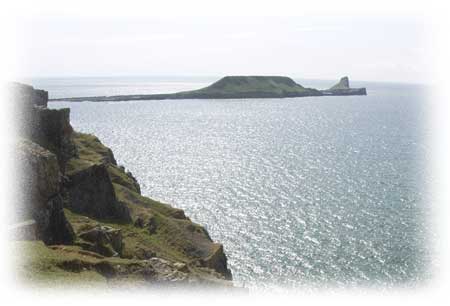|

Above: The Worm's Head - a rocky outcrop off the Gower Peninsula at Rhossili Bay, so named because of its resemblance to the half-submerged head of a giant dragon. (Perhaps waiting for a visit from its Scottish relative, Nessie, the Loch Ness Monster)
In 1956 the Gower Peninsula was designated the UK's first Area of Outstanding Natural Beauty (AONB), with its sweeping beaches, craggy limestone cliffs and pounding surf. About three quarters of the coast is owned by the National Trust (NT) and although there is not a continuous path, you can hike around most of the coastline.
The Gower has the best surfing in Wales, after the Pembrokeshire coast, the most popular surfing beach being the grand 3-mile sweep of Rhossili Bay. This is also the most spectacular beach, and is where you would come to see the sun set over the iconic Worm's Head. The "Worm" referred to here being the dragon which this rocky promontory resembles.
It is about a mile long and a few hundred yards wide and is joined to the mainland by a causeway which is only walkable 2 hours each side of high tide ( so take care not to get marooned there for hours). The Worm's Head is part of a nature reserve that includes the Limestone Nature Trail. You can get details of walks around the Gower from the National Trust Centre at Rhossili.
The highest point on the Gower Peninsula is The Beacon at Rhossili Down at 193m/633ft overlooking Rhossili Bay.
The southern coast of the peninsula consists of a series of small, rocky or sandy bays like Langland and Three Cliffs, and a few larger beaches like Port Eynon, Rhossili and Oxwich Bay.
The main family beaches which are patrolled by lifeguards during the sunmer are Langland Bay, Caswell Bay and Port Eynon. Much of Gower's Northern coast is salt marsh facing across the Burry Inlet, which is an important area for wildfowl and wading birds. There are fewer beaches on the north side, and this part of the coast includes the famouse cockle-beds of Penclawdd.
There are six castles on the Gower Peninsula, Oystermouth (in the Mumbles), Bovehill Castle (also known as Landimore Castle), Oxwich Castle, Pennard Castle, Penrice Castle and Weobly.
